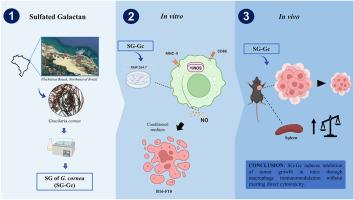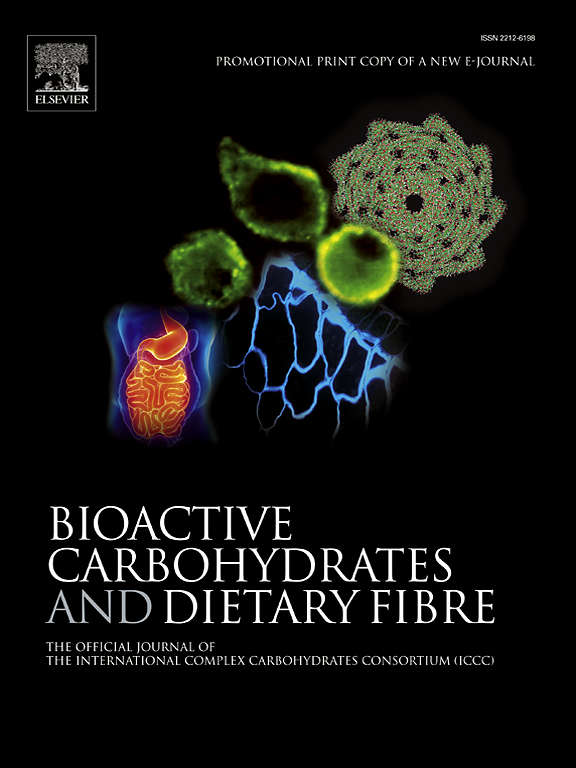Non-cytotoxic sulfated agaran from red seaweed Gracilaria cornea induces antitumor phenotype on macrophages in vitro and inhibits tumor growth in vivo
IF 3.6
引用次数: 0
Abstract
Marine seaweeds are a rich source of sulfated polysaccharides with several biological effects, including antitumor. Some polysaccharides activate macrophages (Mfs) to an antitumor phenotype. In this study, we evaluate whether sulfated galactans (SGs), isolated from red seaweeds Gracilaria cornea (SG-Gc) and Solieria filiformis (SG-Sf), could activate a murine Mfs (RAW 264.7) to an antitumor phenotype. Additionally, we assessed their potential antitumor effects. Both SGs induced nitric oxide release by Mfs. SG-Sf inhibited a murine metastatic melanoma cell line (B16-F10) proliferation compared with the negative control, but SG-Gc did not inhibit B16-F10 proliferation. Notably, a conditioned medium from RAW 264.7 incubated with SG-Gc and SG-Sf inhibited B16-F10 proliferation. Since there was no direct cytotoxicity against B16-F10, we selected SG-Gc for further assays. S SG-Gc induced TNF-α release and increase of the M1 markers iNOS, MHCII, and CD86. Furthermore, 25 mg/kg SG-Gc administered intraperitoneally in B16-F10 melanoma-bearing mice inhibited tumor growth by 60% compared to negative control. In addition, SG-Gc promoted the immunostimulant effect observed on the spleen. No toxic effects were observed in mice treated with SG-Gc. In summary, we identified SG-Gc as an immunomodulatory and antitumor agent.

红藻角叉菜中的无毒硫酸化 agaran 在体外诱导巨噬细胞形成抗肿瘤表型,在体内抑制肿瘤生长
海洋海藻是硫酸化多糖的丰富来源,具有多种生物效应,包括抗肿瘤。一些多糖能激活巨噬细胞(Mfs),使其形成抗肿瘤表型。在本研究中,我们评估了从红藻 Gracilaria cornea(SG-Gc)和 Solieria filiformis(SG-Sf)中分离出的硫酸化半乳糖(SGs)是否能激活小鼠巨噬细胞(RAW 264.7)形成抗肿瘤表型。此外,我们还评估了它们的潜在抗肿瘤作用。两种 SG 都能诱导 Mfs 释放一氧化氮。与阴性对照相比,SG-Sf 能抑制小鼠转移性黑色素瘤细胞系(B16-F10)的增殖,但 SG-Gc 不能抑制 B16-F10 的增殖。值得注意的是,用 SG-Gc 和 SG-Sf 培养 RAW 264.7 的条件培养基可抑制 B16-F10 的增殖。由于SG-Gc对B16-F10没有直接的细胞毒性,我们选择了SG-Gc进行进一步的试验。SG-Gc 可诱导 TNF-α 的释放以及 M1 标志物 iNOS、MHCII 和 CD86 的增加。此外,与阴性对照组相比,B16-F10 黑色素瘤小鼠腹腔注射 25 毫克/千克 SG-Gc 可抑制肿瘤生长 60%。此外,SG-Gc 还能促进在脾脏上观察到的免疫刺激效应。使用 SG-Gc 治疗的小鼠未发现任何毒性反应。总之,我们发现 SG-Gc 是一种免疫调节和抗肿瘤药物。
本文章由计算机程序翻译,如有差异,请以英文原文为准。
求助全文
约1分钟内获得全文
求助全文
来源期刊

Bioactive Carbohydrates and Dietary Fibre
Agricultural and Biological Sciences-Food Science
CiteScore
6.00
自引率
0.00%
发文量
38
期刊介绍:
 求助内容:
求助内容: 应助结果提醒方式:
应助结果提醒方式:


